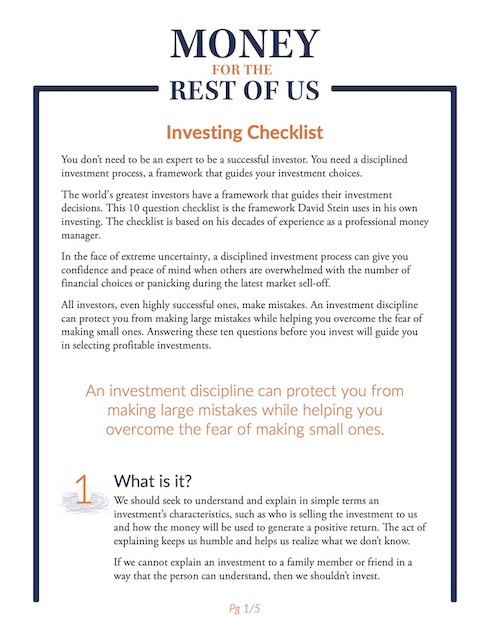Expected portfolio returns are very low right now. Why that is and what should you do about it.

In this podcast, you’ll learn:
- What dentists notice at movies.
- How much you have to save annually to reach a $1 million
- Why estimating what the stock market or bond market will return next year is so difficult.
- Why the best indicators of longer-term stock and bond market returns are today’s conditions.
- What is a bond and what is its yield to maturity and yield to worst.
- Why bond prices move inversely to interest rates.
- How to estimate the intermediate-to-long-term return for the bond market.
- What bonds or the fixed income market are expected to earn over the next decade.
- The three components that comprise stock returns: the dividend yield, corporate earnings growth and what investors are willing to pay for those corporate earnings.
- How a drop in the price-earnings ratio impacts stock returns.
- What stocks are expected to earn over the next decade.
- Why expected returns for investment portfolios are so low.
- What you can do about low expected returns.
Summary Article
Keep Return Expectations Low
A basic question when investing is what rate of return should you expect.
Determining the rate of return for a specific year is extremely difficult due to the wild swings that can occur because of investor fear and greed.
Fortunately, determining a realistic expectation for investment market returns over the next decade is much simpler.
A significant influence on future longer-term investment returns is the starting point. Just as a runner’s fitness level and conditioning is a key indicator as to how fast he or she will run a marathon, the starting conditions for the bond and stock markets are key indicators for what they will return over the next decade or longer.
Expected Bond Returns
Last week, we learned the best estimate of the long-term return for your bond portfolio is what fixed income mutual funds and/or ETFs are yielding today.
Most core bond funds yield between 2% and 4% today so that would be a good proxy for what those funds will return over the next 7 to 10 years. Essentially, about a 3% annualized return.
Expected Stock Returns
How do we estimate a return for stocks? There are three factors that influence long-term stock returns.
The first is the dividend yield, which measures how much income the stocks annually distribute relative to their price.
For example, the dividend yield for U.S. large company stocks as measured by the S&P 500 Index is currently just under 2%.
The second contributing factor is the expected earnings growth for stocks. Over time, aggregate earnings for companies in a given country tend to track the overall growth of the economy.
For example, since 1990, the U.S. economy has grown at an average annual rate before inflation of 4.5%. Meanwhile, earnings for U.S. large company stocks as measured by the S&P 500 Index have compounded at a 4.4% annualized rate over the same period.
Although stock earnings have tracked the U.S. economy over the long-term, they can be quite volatile from year-to-year. Corporate profits can plummet 50% or more during recessions, only to come roaring back during economic recoveries.
Still, a realistic assumption for U.S. large company stock earnings over the next 7 to 10 years would be 4.5% annualized. If we add that number to the current 2% dividend yield, we get an estimated annualized return for stocks of 6.5%.
There is one final factor that contributes to long-term stock market returns. It is also the most difficult factor to estimate. What will investors be willing to pay for those stock earnings ten years from now?
For example, investors are currently paying approximately 19 times trailing 12-month earnings for U.S. large company stocks. That is another way of saying the price-to-earnings ratio (or P/E ratio) of U.S. large company stocks as measured by the S&P 500 Index is 19.
If investors are willing to pay 19 times earnings for stocks a decade from now, then the annualized return for large company stocks over the next decade would be approximately 6.5%.
A P/E ratio of 19 is above average so it’s possible a decade from now investors will be unwilling to pay as much for stock earnings as they do today, which means the return for stocks for the decade would fall below 6.5% annualized.
Expected Portfolio Return
Let’s assume investors will continue to pay the same multiple of earnings so our estimated annualized return for stocks for the next decade is 6.5%. If we assume our estimated return for bonds is 3% annualized from our earlier analysis, then an investor with 50% in stocks and 50% in bond could expect an annualized return of 4.75% over the next 7 to 10 years.
That’s not very high is it? Expected returns are on the low side because bond yields and stock yields are below average and stock valuations are above average.
In other words, the starting conditions are poor. Unfortunately, the only way conditions will improve is if bond yields and stock dividend yields increase and stock valuations fall.
That would require a period of losses on stocks and bonds so that they become more attractively valued. A sobering thought indeed.A friend recently asked me, “What rate of return can I expect to earn from investing?”
